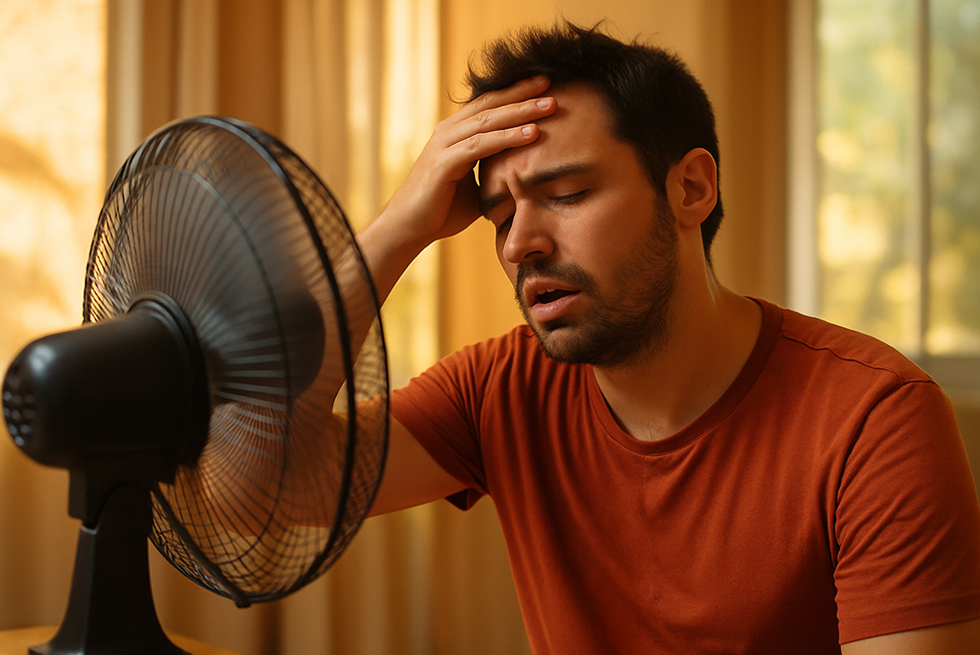During the summer, high temperatures not only pose a risk of dehydration or physical exhaustion: they can also directly affect the proper functioning of the immune system. Heat stroke is not just a passing nuisance, but a phenomenon that can have significant health consequences, especially in vulnerable people.
What is heat stroke?
Heat stroke is a serious medical condition that occurs when the body loses its ability to regulate its internal temperature. When exposure to heat is prolonged and the body fails to cool itself adequately (e.g. through sweating), the body temperature can exceed 40 °C, triggering an extreme physiological response.
Common symptoms include:
- Dizziness and confusion
- Headache
- Hot, dry skin
- Nausea
- Loss of consciousness, in the most severe cases
Impact of extreme heat on the immune system
The body responds to excessive heat by generating a systemic inflammatory reaction. This process affects different systems, including the immune system:
- Heat stress: Prolonged exposure to heat leads to increased oxidative stress, which promotes inflammation and weakens natural defences.
- Alteration of immune cells: It has been observed that the function of key cells such as lymphocytes or macrophages may be compromised in high temperatures.
- Affected gut microbiota: Heat can also alter the gut flora, which has an impact on immune regulation.
- Immune fatigue: When the body works hard to cool down and maintain homeostasis, there is a general wear and tear, including reduced effectiveness of the immune system.
Heat stress not only affects the immediate physical level, but can leave the body more exposed to further infection or inflammation.
Key preventive measures
Avoiding heat stress is essential, especially during heat waves or in regions with very high temperatures. Here are some evidence-based recommendations:
- Adequate hydration: Drink water consistently throughout the day, even if you are not thirsty. Water-rich fruits (such as watermelon or cantaloupe) also help to maintain optimal hydration.
- Sun protection and shade: Avoid exposure to the sun between 12:00 and 17:00, wear hats, sunglasses and broad-spectrum sunscreen.
- Balanced diet: Including foods rich in antioxidants, vitamins and minerals promotes a better immune response. Summer offers ideal fresh produce such as raw vegetables, fruit and fish.
- Light clothing and cool environments: Wear light-coloured cotton or linen clothing and stay in well-ventilated or air-conditioned spaces.
Heat stroke is a risky situation that goes beyond thermal discomfort: it can compromise the body’s immune balance, leaving the body more vulnerable to pathogens. In summer, it is essential to adopt habits that protect not only from the heat, but also from the impact it can have on our general health.
Bibliography
- Epstein Y, Yanovich R. Heatstroke. N Engl J Med. 2019;380(25):2449–59. doi:10.1056/NEJMra1810762
- Leon LR, Helwig BG. Heat stroke: role of the systemic inflammatory response. J Appl Physiol (1985). 2010;109(6):1980–8. doi:10.1152/japplphysiol.00301.2010
- Bouchama A, Knochel JP. Heat stroke. N Engl J Med. 2002;346(25):1978–88. doi:10.1056/NEJMra011089
- Lim CL. Fundamental concepts of human thermoregulation and adaptation to heat: a review in the context of global warming. Int J Environ Res Public Health. 2020;17(21):7795. doi:10.3390/ijerph17217795
- Gleeson M. Immune function in sport and exercise. J Appl Physiol (1985). 2007;103(2):693–9. doi:10.1152/japplphysiol.00008.2007
- Centers for Disease Control and Prevention (CDC). Extreme Heat: Heat-Related Illness [Internet]. Atlanta (GA): CDC; [actualizado periódicamente; citado 2025 May 30]. Disponible en: https://www.cdc.gov/disasters/extremeheat/heat_guide.html
DIG-2-0593-072025


